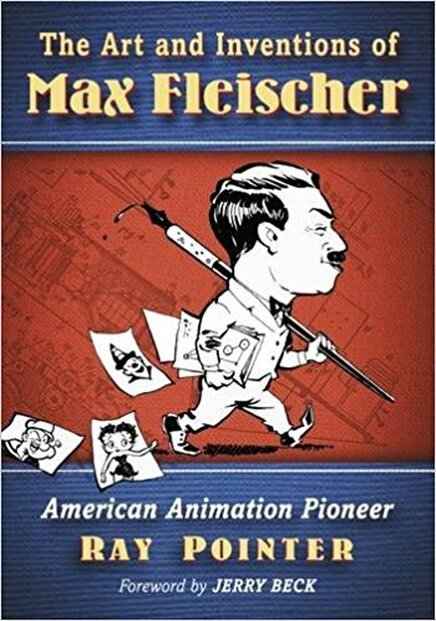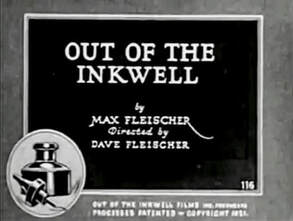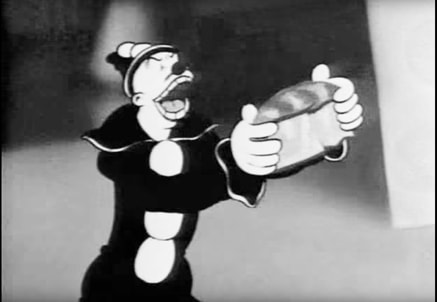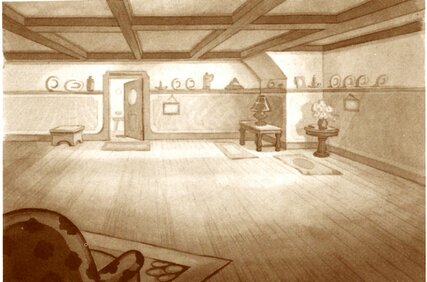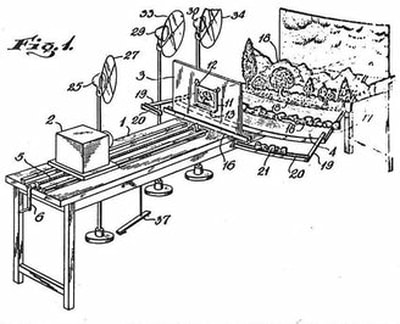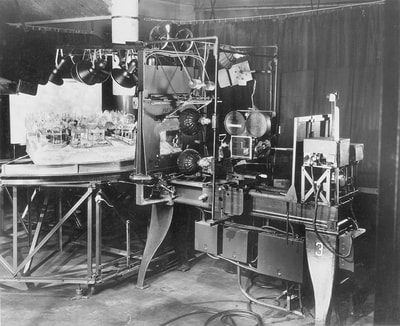Audible Thought BalloonsPart One of our interview with Ray Pointer,
author of The Art and Inventions of Max Fleischer The Art and Inventions of Max Fleischer, a new book by Ray Pointer who is a preeminent animation historian, and animator in his own right, takes the reader on an amazing journey - not just through Fleischer Studios - but through the entire history of animation.
This comprehensive new book is the result of Mr. Pointer's 40-plus year commitment to investigating and studying Fleischer cartoons - and the work of Max Fleischer in particular. The book, which includes a forward by Jerry Beck, is now available on a number of websites including Amazon. We were curious to talk to Mr. Pointer about this exciting new book, what led him to write it and the impact of Fleischer Studios, and its innovative work, on animation history. For this interview we matched Mr. Pointer with Jane Reid, a member of the Fleischer Studios Board of Directors ... and Max Fleischer's granddaughter! We are thrilled to share the first part of their conversation below. Stay tuned for more of this fascinating interview in the coming weeks.
|
|
|
Jane: What would you say was your greatest influence from Max Fleischer?
 Frank Goldman (photo courtesy of Ray Pointer) Frank Goldman (photo courtesy of Ray Pointer)
Ray: There were many. Of course, my greatest influence was his Popeye cartoons. I was always fascinated by the ones with the special three dimensional background effects. I was also fascinated by the dance sequences that were so well animated. I remember vowing "One day I'll know how this is done!" And I set out to do that some years later when I started my research.
Jane: And what got you started on that research? Ray: The summer before I started high school, I got my first professional animation exposure at Jam Handy, and met several Animators who had worked for Fleischer Studios. It was during my job interview that I was introduced to two pioneers of the animation field, Frank Goldman and his best friend Max Fleischer. While the circumstances are not clear, I gathered that Max was on a brief visit on his way to the west coast when he came to see Frank. I go into this in detail in my book. It was then that I learned that Max was an inventor. Frank and others told me many things about Max that had never been documented. I recognized that these stories needed to be culled together in some form, especially since all histories of animation up to that time were focused solely on Walt Disney to the extent that it seemed no one else existed in the field. I came to the realization that Max was actually the foundation for what later became the Disney empire. Jane: Where else did you go for information for your book?
Ray: Aside from a few brief references in obscure newspapers, magazine articles, and books, the only extensive information to be found on Max Fleischer was a four page entry in The Richardson Encyclopedia, and a listing in The Motion Picture and Television Almanac. These sources at least gave me a starting point and reference, placing Max in the field a decade before Disney got started. In fact, Max was pioneering the animation field when Walt was only 14 years old. |
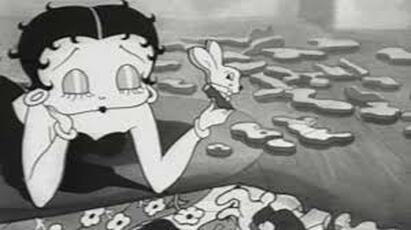 Betty works on a jigsaw puzzle in "Betty in Blunderland" Betty works on a jigsaw puzzle in "Betty in Blunderland"
But I finally made the full plunge into my research when I started at Wayne State the fall of 1970. The main branch of The Detroit Public Library was near the campus, and after classes, I looked up all of the copyright registrations to trace Max's studio history. The library also had an extensive Patent Library due to the city's connection to industry. So I looked up every patent in Max's name. I also combed through every periodical looking for news clippings and magazine articles. After two years, this material was exhausted and the holes were still not filled. By this time Max had passed away. I contacted Max's son, Richard, who graciously referred me to his sister, Ruth Kneitel. Ruth was very cordial and generous. Her initial question to me was "Why are you interested in my dad's career?" I answered quickly, "I guess I've always liked jigsaw puzzles." Ruth laughed, responding with "You're right, my dad's life was something of a jigsaw puzzle!"
Jane: What were you hoping to do with all of the pieces to the jigsaw puzzle?
Ray: I was interested in producing a documentary on Max Fleischer while I was enrolled in the Film and Television program at Wayne State. Max's cartoons had been off television for five years largely because the bulk of them were in black and white and television had gone to all color. But there were special film history programs being produced for National Educational Television, which later became PBS. I quickly learned that a good share of the milestone films were considered lost, or existed in poor condition. In other cases, the use rights were very complicated, and the university seemed unable to take on a project of this nature. So I considered writing a book. It was at this time I learned through Ruth that a book was in the works by Leslie Cabarga in San Francisco. She suggested contacting him and gave me his address. When I contacted Leslie, it seemed I had the missing details he needed for his book. We made a friendly exchange through the mail, and spoke on the phone several times. I could see that he needed the help of someone understanding the medium. And most of all, since there had never been a book on Max, I considered the bigger picture, and gave him a copy of my notes in order to help make the book as good as it could be. That was 40 years ago.  Max Fleischer Max Fleischer
Jane: And that brings us to why you've written your book.
Ray: People have tapped into me for information on Max Fleischer for many years. And many artifacts thought to have been lost over the decades have surfaced in recent years. At the same time, many people continue to be interested in the subject of Max Fleischer as an alternative to the Disney story, which has been overexposed. Most of what was being written was done by fans with good intentions, but confused in content and limited to career summaries. The problem with writing about this subject is that it requires the understanding of many things on many levels including 20th Century history, American Cultural History, as well as art, animation, and film technologies, with something of an understanding of psychology. Writing about animation first of all is a challenge since it's a moving art form that needs to be seen to be totally realized. Most authors writing about animation are not artists, animators, or film makers. This makes it difficult for them to understand the creative mind and the disciplines involved with making animated cartoons. What people really want to know is "how were the cartoons made," and most of all, "what made these men 'tick'?" This was my approach in writing my book - to share my insights combined with qualified sources on this fascinating subject and the man at the center of it. It's not enough to say that I just told the story because, in a sense, I've lived it!
 Ray Pointer Ray Pointer
Ray Pointer “rolled off the Assembly Line" at Henry Ford Hospital on July 4, 1952. He attended Special Ability Art classes at The Detroit Institute of Arts, and graduated from Cass Technical High School, earning a Commercial Art degree. He attended Wayne State University and the University of Southern California, Department of Cinema/Television.
A self-taught filmmaker, Ray experimented with animation from 1963 to 1973, with his first professional exposure at The Jam Handy Organization in Detroit. And in 1973, he received the first Student Oscar for the cartoon short, Goldnavel. Ray served in the U.S. Navy as a Motion Picture Specialist, serving in a junior officer’s position as Producer for Navy Broadcasting in Washington D.C. During this period, he received The Gold Screen Award from the National Association of Government Communicators for the animated television spots: Pride and Professionalism and Shore Patrol. In the 1990s, Ray was active in the Animation Renaissance on the west coast, as an Assistant Animator and Storyboard Artist for Film Roman, DIC Entertainment, Hanna-Barbera, Universal, Disney Interactive, Fred Wolf Films, MGM, and Nickelodeon, where he advanced to Animation Director. In 1996, Ray became an active member of The Animation Peer Group of The Television Academy of Arts and Sciences. Since 2009, Ray has been an Adjunct Professor in Digital Media at Kendall College of Art and design in Grand Rapids, Michigan. In 2000, Ray began assembling a selection of the early Max Fleischer Out of the Inkwell and Ko-Ko Song Car-tunes films, which are available on DVD from his web site, www.inkwellimagesink.com. Learn more about Ray Pointer's search for Out of the Inkwell films at TraditionalAnimation.com |
